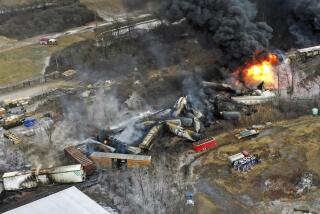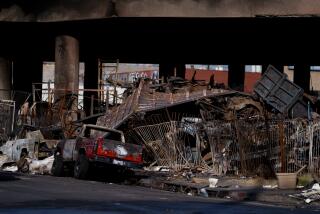Train Inspection Canceled After Railroad Complaint : Transportation: Southern Pacific said prior reviews hurt the company. Federal safety chief defends his actions.
The federal chief of railroad safety in the West disclosed Thursday that he canceled an inspection of Southern Pacific freight cars after a company official complained that a previous inspection--which found chronic locomotive defects--had hurt the carrier financially.
H.T. (Tom) Paton, regional director of the Federal Railroad Administration, said at a hearing in Los Angeles that he called off the June 23 inspection at Colton even though four FRA reviews earlier in the month found that 83% of Southern Pacific’s locomotives were defective.
Paton said he made the decision after Southern Pacific’s chief mechanical officer telephoned him at home to complain that the carrier lost more than $1 million when rail traffic was interrupted by a three-day inspection in Tucson, ending June 20.
Southern Pacific spokesman Mike Brown acknowledged that the railroad protested the disruption of service in Arizona but denied that it was seeking to have further inspections canceled.
“I felt I had pushed the SP about as far as I could,” Paton said of his decision to suspend the Colton inspection and divert his staff to a Santa Fe railroad facility in Barstow. “Maybe it was bad judgment to postone the inspection. Nevertheless, I elected to do that.”
Paton’s comments came at a legislative hearing to address safety questions raised by two Southern Pacific derailments. One, on July 14 near Dunsmuir, spewed a hazardous pesticide into the Sacramento River, wiping out all aquatic life on a 45-mile stretch leading to Shasta Lake. The second, on July 28 at Seacliff, punctured drums of toxic aqueous hydrazine, forcing scores of residents from their homes and closing the Ventura Freeway for five days.
Paton said there was no relationship between the canceled inspection in Colton and the back-to-back derailments, which remain under investigation.
Investigators believe that the Dunsmuir derailment was caused by a faulty locomotive that was unable to pull the long line of cars uphill, while the Seacliff accident is believed caused by a faulty freight car bearing. Neither the suspect locomotives on the Dunsmuir train nor the freight car bearing would have been inspected in Colton, Paton said.
Nonetheless, Assemblyman Richard Katz (D-Sylmar)--who convened Thursday’s hearing--said Paton’s actions suggest that federal oversight of rail traffic is inadequate to prevent potentially more dangerous spills of hazardous materials.
He added that the Public Utilities Commission--the state agency charged with policing the railroads--has etched an “appalling” record by failing to take independent enforcement action against Southern Pacific when maintenance problems persisted.
“It’s clear the people with the authority to protect the public aren’t doing their job,” said Katz, chairman of the Assembly transportation committee, adding that he found Southern Pacific’s maintenance record “shocking.”
“It seems that there are plenty of people concerned about the railroad’s interests and nobody watching out for public safety,” he said.
Robert Starzel, vice chairman of the Southern Pacific Transportation Co., defended the railroad’s record. He said safety is the key to running a reliable carrier and is “the basis for our survival as a company.”
Starzel also called the large number of deficiencies reported by FRA inspectors “misleading,” charging that most of the defects found amount to little more than “dirty windshields.”
“These are white glove inspections,” Starzel said.
Paton disagreed.
In an interview, he conceded that dirty windshields represent a violation of railroad rules. But he said the FRA’s findings during inspections of Southern Pacific this year included much more substantial problems, among them fuel, oil and exhaust leaks, which together can cause fires; faulty or inoperative gauges, and wheel and gear defects.
Paton and his boss, Ed English, director of safety for the FRA in Washington, said the problems detected were more a threat to crew safety than a potential cause of accidents.
Federal safety officials said in the case of serious defects--such as faulty brakes that might cause a derailment--cars are tagged and must be repaired and inspected again before they can be returned to service. For less serious defects, no follow-up inspection takes place.
Paton said he did not have specifics of the four inspections conducted in June. A top state rail safety official in Arizona said the joint federal-state inspection in Tucson on June 18-20 found that 35 locomotives examined in one day had serious defects.
The problems included leaking fuel lines, dangerous oil accumulation and improperly secured fuel tanks, said the official, who asked not to be named. Inspectors also found blockages of holes that released sand onto the tracks, a measure that aids traction during bad weather.
“They (Southern Pacific) have a very poor inspection program,” said the Arizona official. “Something should be done . . . maybe schooling or something like that for their inspection people.”
Paton agreed that Southern Pacific has had a poor record of compliance with federal rules relating to locomotive maintenance. In February, 1990, he said, the FRA conducted inspections in Tucson and Phoenix and found that 100% of the locomotives examined--53 out of 53--were defective.
In response, Paton said Southern Pacific officials promised to cut that locomotive defect rate in half by July, 1990.
“They haven’t made it,” Paton testified. “I’m not happy.”
Paton said he decided to pursue “an aggressive compliance program” against the railroad in June. On June 4 at a Sparks, Nev., Southern Pacific yard, FRA officials found that 43 of the 50 locomotives they inspected were defective and listed 255 defects. A week later, inspectors in Roseville rated 48 of 61 locomotives defective and found 116 defects.
At the same time, inspectors were in Bakersfield, where they rated 36 of 45 Southern Pacific locomotives as defective and counted 87 deficiencies. On June 18, inspectors arrived in Tucson, where 79 of 92 locomotives failed to pass muster and 255 defects were tallied.
Paton said he did not know how many of the deficiencies were written up as formal violations, which trigger financial penalties.
Given the record, Katz asked Paton why he called off the Colton inspection, which was targeted at freight cars, not locomotives.
Paton responded that he already had caused “a serious disruption” of Southern Pacific service because of the Tucson inspection and felt that further scrutiny might damage his working relationship with the railroad.
Moreover, the FRA official said he was “advised by the (Southern Pacific) chief mechanical officer that (company officials) do not feel it was the intent of Congress to give the FRA the ability to bring a railroad to its knees, which is basically what I had done in Tucson.”
“Why should you give a damn about the fiscal concerns of the railroad when your job is the safety of the public?” Katz asked.
Paton replied that to “achieve increased compliance (with federal rules), I have to maintain some degree of credibility with the railroads.” Easing up on Southern Pacific in Colton, he said in an interview, seemed “the best way to get them” to address the maintenance problems.
“The challenge is to find the best way to deal with a railroad, to get them into compliance,” said Paton, noting that FRA’s small inspector staff limits its monitoring ability. “In this case I felt I was using good judgment to back off in Colton. . . . We’re not here to bankrupt the railroad.”
More to Read
Sign up for Essential California
The most important California stories and recommendations in your inbox every morning.
You may occasionally receive promotional content from the Los Angeles Times.









